
USS Brooklyn was a sloop-of-war authorized by the U.S. Congress and commissioned in 1859. Brooklyn was active in Caribbean operations until the start of the American Civil War at which time she became an active participant in the Union blockade of the Confederate States of America.

The Battle of Mobile Bay of August 5, 1864, was a naval and land engagement of the American Civil War in which a Union fleet commanded by Rear Admiral David G. Farragut, assisted by a contingent of soldiers, attacked a smaller Confederate fleet led by Admiral Franklin Buchanan and three forts that guarded the entrance to Mobile Bay: Morgan, Gaines and Powell. Farragut's perhaps apocryphal order of "Damn the torpedoes! Four bells. Captain Drayton, go ahead! Jouett, full speed!" became famous in paraphrase, as "Damn the torpedoes, full speed ahead!"

CSS Tennessee was a casemate ironclad ram built for the Confederate Navy during the American Civil War. She served as the flagship of Admiral Franklin Buchanan, commander of the Mobile Squadron, after her commissioning. She was captured in 1864 by the Union Navy during the Battle of Mobile Bay and then participated in the Union's subsequent Siege of Fort Morgan. Tennessee was decommissioned after the war and sold in 1867 for scrap.

The second USS Metacomet was a wooden sidewheel steamer in the United States Navy during the American Civil War. The ship was named for Metacomet, a war chief of the Wampanoag Indians.
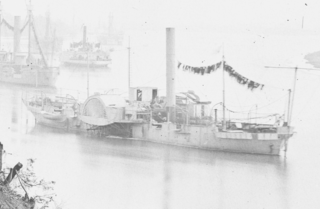
The first USS Miami was a side-wheel steamer, double-ender gunboat in the United States Navy during the American Civil War.

CSSSelma was a steamship in the Confederate States Navy during the American Civil War. She served in the Confederate Navy first as Florida, and later as Selma. She was captured by the Union Navy steamer USS Metacomet during the Battle of Mobile Bay. She served as USS Selma until the end of the war, when she was decommissioned and sold for use as a merchant ship.
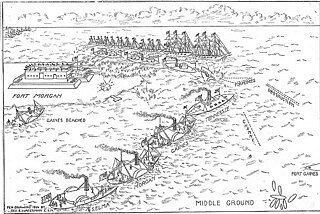
CSSMorgan was a partially armored gunboat of the Confederate States Navy in the American Civil War.
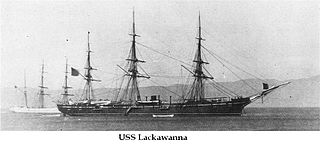
The first USS Lackawanna was a screw-propelled sloop-of-war in the Union Navy during the American Civil War. She was named after the Lackawanna River in Pennsylvania.

USS Kennebec was a Unadilla-class gunboat built for the U.S. Navy following the outbreak of the American Civil War. She was named for the Kennebec River.
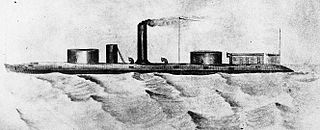
USS Winnebago was a double-turret Milwaukee-class river monitor, named for the Winnebago tribe of Siouan Indians, built for the Union Navy during the American Civil War. The ship participated in the Battle of Mobile Bay in 1864, during which she was lightly damaged, and the bombardments of Forts Gaines and Morgan as Union troops besieged the fortifications defending the bay. In early 1865, Winnebago again supported Union forces during the Mobile Campaign as they attacked Confederate fortifications defending the city of Mobile, Alabama. She was placed in reserve after the end of the war and sold in 1874.
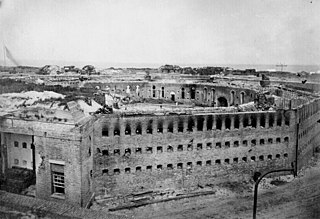
The siege of Fort Morgan occurred during the American Civil War, as part of the battle for Mobile Bay, in the Confederate state of Alabama during August 1864. Union ground forces led by General Gordon Granger conducted a short siege of the Confederate garrison at the mouth of Mobile Bay under the command of General Richard L. Page. The Confederate surrender helped shut down Mobile, Alabama, as an effective Confederate port city.
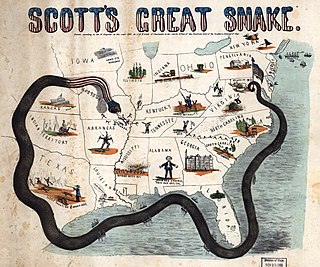
The lower seaboard theater of the American Civil War encompassed major military and naval operations that occurred near the coastal areas of the Southeastern United States: in Alabama, Florida, Louisiana, Mississippi, South Carolina, Texas, Port Hudson, Louisiana, and points south of it.

USS John P. Jackson was a sidewheel steamer acquired by the Union Navy during the beginning of the American Civil War. Built in 1860, John P. Jackson was used as a ferry by the New Jersey Rail Road and Transportation Company. In February 1861, she ferried President-elect Abraham Lincoln on his way to his inauguration. She was purchased for use in the American Civil War on 6 November. Commissioned for military service on 14 February 1862, she was sent to Ship Island. On 4 April, she was part of a battle with Confederate vessels near Pass Christian, Mississippi. That same day, she captured the blockade runner P. C. Wallis. In April, she bombarded Confederate-held Fort Jackson and Fort St. Philip. Next month, John P. Jackson participated in a scout of Lake Pontchartrain.
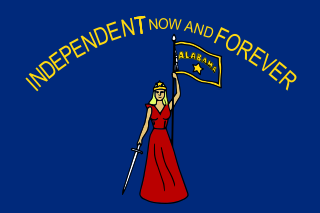
Alabama was central to the Civil War, with the secession convention at Montgomery, the birthplace of the Confederacy, inviting other slaveholding states to form a southern republic, during January–March 1861, and to develop new state constitutions. The 1861 Alabaman constitution granted citizenship to current U.S. residents, but prohibited import duties (tariffs) on foreign goods, limited a standing military, and as a final issue, opposed emancipation by any nation, but urged protection of African-American slaves with trials by jury, and reserved the power to regulate or prohibit the African slave trade. The secession convention invited all slaveholding states to secede, but only 7 Cotton States of the Lower South formed the Confederacy with Alabama, while the majority of slave states were in the Union at the time of the founding of the Confederacy. Congress had voted to protect the institution of slavery by passing the Corwin Amendment on March 4, 1861, but it was never ratified.
USS Itasca was a Unadilla-class gunboat built for the U.S. Navy during the American Civil War. She was used by the Navy to patrol navigable waterways of the Confederacy to prevent the South from trading with other countries.

USS Octorara was a steamer acquired by the Union Navy during the American Civil War. She was used by the Navy to patrol navigable waterways of the Confederacy to prevent the Confederates from trading with other countries.
The following outline is provided as an overview of and topical guide to the American Civil War:
The Milwaukee-class monitors were a class of four riverine ironclad monitors built during the American Civil War. Several supported Union forces along the Mississippi River in mid-1864 before participating in the Battle of Mobile Bay in August. Chickasaw and Winnebago bombarded Confederate coastal fortifications during the battle and during subsequent operations as well as engaging the ironclad Tennessee II. The other two ships arrived at Mobile Bay after the battle and all four supported the land attacks on Mobile in March–April 1865. Milwaukee struck a torpedo during this time and sank. The surviving three ships were sold in 1874; Chickasaw was converted into a ferry and survived until 1944 when she was scuttled. Her wreck was discovered in 2004.
The Mobile campaign was a military campaign of the American Civil War in the western theatre in the Spring of 1865 to take the city of Mobile, Alabama. Opposing forces included the Union Army, and the Confederate Army. Important battles were fought at Spanish Fort and Fort Blakeley.
















